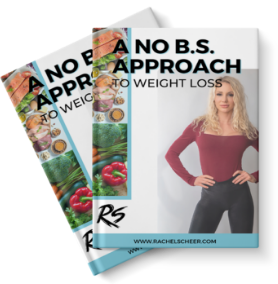The Top 10 Lies the Food Industry is Feeding You
1. Low-Fat, Reduced-fat, or Fat-Free
Less fat = better, right? WRONG! These snack items may seem like they are helping you out with your waistline, but in reality these items are often loaded sugar and other additives in order to make up for taste. Fats have been unfairly demonized in the past but evidence now shows that it is excess sugar and simple carbohydrates that are the real cause for weight-gain.
2. Includes Whole Grains
Over the past decade, whole grains have been advertised as healthy. And I agree, that whole-grains are better than refined, processed grains. But grains in general are very inflammatory to the body and often spike your blood sugar just as fast as their refined counterparts. Plus, even if a product has a small amount of whole grains in it, it is often loaded with other harmful ingredients like sugar, high-fructose corn syrup, shelf-stabilizers, and fillers.
3. Gluten-Free
Just so we are clear, I fully support a gluten-free diet as there is evidence that a large proportion of people may be sensitive to gluten and wheat. However, processed items labeled as “gluten-free” does not mean that they are healthy. These foods are made from highly refined, high-glycemic starches, like corn starch, potato starch and tapioca starch, and often loaded in sugar. Eating gluten free should be about ditching refined foods, like cereals, cookies, chips, and replacing them with real, whole foods.
4. Hidden Sugar
It bewilders me that most people will not even look at the ingredients list of an item before purchasing it. But EVEN for those who do, food manufacturers have ways of disguising the true contents of their products. On ingredients lists, the components are listed in descending order by amount in that product. If you see sugar in the first few ingredients listed, then you know that product is loaded in sugar. However, food manufacturers often put different types of sugar in their product, or label them with different names. For example, corn sweetener, corn syrup, dextrose, fructose, fruit juice concentrates, glucose, high-fructose corn syrup, invert sugar, lactose, maltose, malt syrup, raw sugar, sucrose, sugar syrup, cane crystals, cane sugar, crystalline fructose, evaporated cane juice, corn syrup solids, malt syrup, are all different names for the exact same thing—sugar!
5. Calories per serving.
A manufacturer can decide that a chocolate bar or soda bottle is two servings, even though that most people do not stop until they have finished the whole thing. Food producers use this to their advantage by saying their product is low in calories, when in reality the whole product is not. When reading labels, check the number of servings the product contains. For example, a 24-ounce (.7-liter) bottle of soda may contain 100 calories and 27 grams of sugar per serving. If the entire bottle contains three servings, the total amount is 300 calories and 81 grams of sugar. I do not know about you, but back in my soda drinking days, I could easily down 24 ounces in one sitting!
6. Fruit-Flavored
A lot of processed foods have a flavor that sounds natural, and it even sometimes uses to word “natural” along with describing it. But just because a product has the flavor of a real food, like blueberry, strawberry or orange, does not mean that any of it is actually in there. For example, orange-flavored Vitamin Water tastes like oranges. However, there is no actual oranges in there! The sweet taste is coming from the sugar and the orange flavor is coming from artificial chemicals.
7. Small Amount of Healthy Ingredients
Processed products love to sell you on the little healthy ingredients that are in their products. This is purely a marketing trick, just because there are some ingredients that are commonly considered healthy, it does not make up for the harmful effects of the other ingredients. This way, clever marketers can fool consumers into thinking they are making healthy choices. Some examples of ingredients often added in tiny amount and then displayed prominently on the packaging are: Omega-3s, antioxidants, whole-grains, and fiber. Basically, if a food is trying to CONVINCE you it is a healthy choice through advertising, it probably is not the best choice. You never see broccoli yelling at you with all of its health benefits!
8. Hiding Controversial Ingredients
Many people choose to avoid certain food ingredients for health reasons. However, food manufactures often hide these controversial ingredients by referring to them with technical names that people don not know. For example, in Europe MSG (monosodium glutamate) may be called E621 and carrageen may be called E407. The same can be said for many types of sugar, such as “evaporated cane juice”—it sounds natural, but it is really just sugar!
9. Low-Carb Junk Foods
Food manufacturers catch on to the latest trends in nutrition and start offering products to fit the consumers. With low-carb diets on the rise, low-carb options are now about as prevalent as their low-fat counterparts. The problem with these “low-carb” foods is the same as the “low-fat” foods—they not necessarily healthier. These are usually processed junk foods filled with unhealthy ingredients. Just look at the ingredients on an Atkins bar, for example.
Does this look like real food to you? These bars are highly processed with a massive amount of artificial chemicals, some of which are potentially harmful. There are also examples of low-carb breads and other replacement products that contain many more carbs than the label claims.
10. “Organic” Unhealthy Ingredients
I do believe buying certain organic whole foods is better because it avoids the use of chemicals and pesticides in farming. But the way many food manufactures use the word “organic” is misleading. For example, when you see raw organic cane sugar” on an ingredient list, this is the exact same thing as regular sugar. Junk food is still junk food, even if it’s organic.
The Bottom Line
Try to limit your intake of processed foods altogether and focus on eating real, whole foods instead! That way, you don not have to worry about labels, ingredients list, false advertising, or any of the other tricks the food industry tries to scam you with! Real food doesn’t even need an ingredients list. Real food IS the ingredient!

Rachel Scheer is a Certified Nutritionist who received her degree from Baylor University in Nutrition Science and Dietetics. Rachel has her own private nutrition and counseling practice located in McKinney, Texas. Rachel has helped clients with a wide range of nutritional needs enhance their athletic performance, improve their physical and mental health, and make positive lifelong eating and exercise behavior changes.
Read This Next
Micronutrients, or the vitamins and minerals your body needs, typically work like a team. To…
If you want to improve gut health, or even optimize your overall health, you’ve probably…
Have you ever found yourself grappling with the discomfort of abdominal distension, bloating, or cramping,…



